One of the hallmarks of the Overseas Adventure Travel (our safari
tour provider) program is to spend time with local people in their everyday
environment. To that end, after another
hearty breakfast (another hallmark-- lots of food three times a day), we head off
to a Datoga (one of the 120+ tribes in Tanzania) boma and spend an hour or so
walking through the enclosure and various huts.
This boma (an area enclosed by a fence) is owned by MamaMaria, whose
husband was killed by a lion about six years ago while defending his cattle,
leaving her to manage the boma, the good-sized collection of goats, sheep and
cattle (Craig calculated about $40,000 worth at the going rate of $400 per cow),
and three children. She and her elder
daughter, Maria, are beautifully
dressed and very gracious in showing us
around. We marvel at how she can manage
it all alone between fuel gathering, livestock grazing every day, feeding her
family, and keeping the compound well maintained. Oh, and fending off lions.
Next we headed to a Maasai village where both the men and women
of our group participate in various village daily activities. After introductions, first on the agenda was
the opportunity to drink cow blood. They
led us to a group of cattle for what we thought was to
be a demo of the
technique. In fact they picked out a
likely beast, fitted a blunt arrow into a bow and proceeded to shot it in an
artery in the neck. The blood that
spurted out was captured in a gourd of some kind and passed around. After giving a reasonable amount of blood the
cow was patched up with some mixture of earth and herb and sent on its
way. No one in our group actually
partook of the proffered delicacy.
The village women arrive with a ceremonial song and march,
then each of them takes one of us (females) by the hand, shares necklaces with
us, and leads us each out to participate in a
traditional dance. Phyllis’ mentor, also named Maria, was the
lead singer in the welcoming song and is the daughter of the village patriarch
and sister to the current chief, Lobulu.
She is very tolerant of Phyllis’ clumsy dancing and seems pleased (but
speaks no English so we had to use sign language). The men then all participate in some sort of
jumping dance with the Maasai men.
Later, we women are led off to learn the practice of plastering a hut with a mixture
of mud and cow dung (!!!) and carrying loads of firewood on our heads (Phyllis did not drop
her
limb). During that time, the men in our group do men things, which
consists of drinking molasses-based moonshine with the Maasai men. Apparently the women do all the hard work
around here. In fact, we later learn that
the men can live to 90, while the average lifespan of a Maasai woman is 47
years. Even taking into account the
likely high rate of death in childbirth, this is a pretty startling
statistic.
The Maasai are essentially a
nomadic society, measuring wealth and stature by the number of their cattle,
and they build villages that can be moved when the need arises. They
originally migrated down the Nilotic spine
of Africa from the far north and stopped just about here in Tanzania. Although Phyllis joked that the men around
the village seemed a bit lazy, the work of protecting the cattle and families
from wild animals is no small task.
Lobulu showed us the scars from his youthful encounter with a lion, and
recall that MamaMaria’s husband was lost to a lion attack too. This is not an easy life for anyone. It is another one of those moments where we
realize how lucky we were with the date and place of our birth.
The Maasai are a very interesting people. They have a reputation as fierce warriors, which
is apparently mostly deserved. On the
one hand at every lodge where we stayed, the guards were Maasai and as
described above they do not hesitate to take on a lion when their cattle
are
attacked. One of our fellow travelers
recounted how in Nairobi when you had to travel in this somewhat dangerous city
after dark you would call up a service that would send a Maasai (with spear) to
escort you to your destination. On the
other hand, our chief guide Ronald recounted an incident some years ago when he
was taking a client group on a “walking safari” escorted by several Maasai
warriors armed with spears. They
unexpectedly came upon a group of elephants from which one large bull began to advance
toward them at a rapid pace, trumpeting as he came. Ronald looked back to get direction from the
Maasai as to what to do only to see them, spears flung
aside, heading over a rise. Later it was explained to him that while the
Maasai will fiercely face a lion, they have no stomach for defending against an
assault by an elephant, which apparently usually involves an inevitable and
particularly gruesome death.
Interestingly, in spite of their warrior reputation, they are herdsmen
and do not hunt or eat wild game. The
Maasai’s other reputation is as world class cattle thieves, apparently
resulting from a cultural misunderstanding by which the Maasai mistakenly
believed that all
cattle in the world belong to Maasai. Thus, whenever they found some being herded by
other tribes they were obligated to bring them home. It reportedly took the national governments
quite a while to correct this belief.
After leaving the Maasai village, we head to the Tloma Lodge
in the small town of Karatu near the Ngorongoro Conservation Area, where we
spend the night before a long drive to the
Serengeti. The Lodge is one of eight owned by the same
man who owns Kibo Guides, the outfit that is contracted to OAT, our tour
operator, to actually conduct the safari.
Tloma fits our Rudyard Kipling-ish image of colonial tropical outpost,
composed of a large compound surrounded by a concrete wall to keep the
“megafauna” out of the extensive flower, vegetable, fruit, and coffee terraces
which provide the foods served at meals.
We drove through a downpour before arriving, and this entire
area is at
about 8,000 feet in elevation, so it was comfortably chilly after the earlier heat of the day. We strolled the grounds
and enjoyed yet another excellent and large meal. Our rooms and decks looked out over the
terraces with the Ngorongoro highlands in the misty distance.

 Karatu, Manyara Region, Tanzania
Karatu, Manyara Region, Tanzania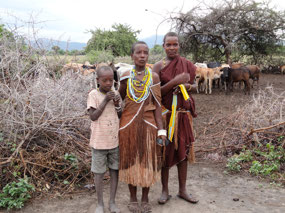

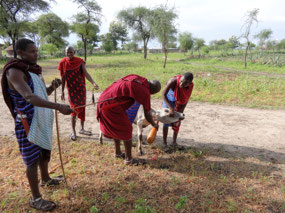
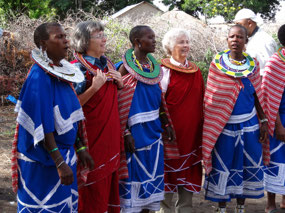
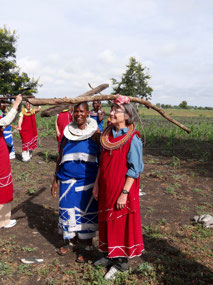
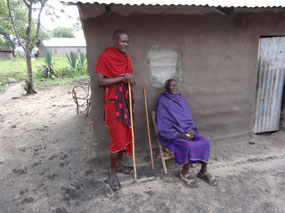
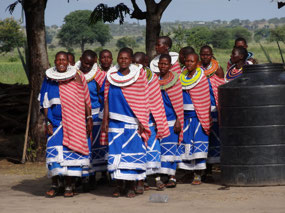

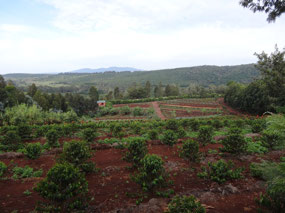
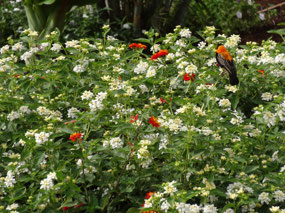
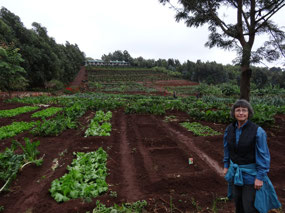




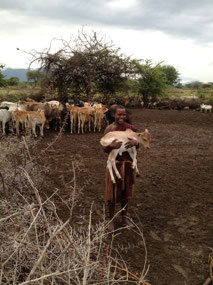
2025-05-23